西蒙购物中心
期末,我们开始了一个新项目,西蒙购物中心
一、功能需求
1、只有注册用户成功登录之后才可查看商品类别,查看商品,选购商品,生成订单、查看订单。
2、只有管理员才有权限进入购物网后台管理,进行用户管理、类别管理、商品管理与订单管理。
二、设计思路
1、采用MVC设计模式
分层架构:展现层(JSP)<——>控制层(Servlet)<——>业务层(Service)<——>模型层(Dao)<——>数据库(DB)
2、前台
(1)登录——显示商品类别——显示某类商品信息——查看购物车——生成订单——支付
(2)注册<——>登录
3、后台
(1)用户管理:用户的增删改查
(2)类别管理:商品类别的增删改查
(3)商品管理:商品的增删改查
(4)订单管理:订单的查看与删除
步骤一:我们需要创建数据库,插入脚本

步骤二:创建Web项目simonshop

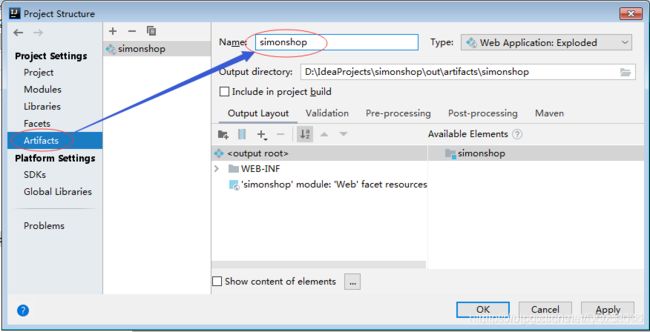
接下来是配置


步骤三:
在src里创建net.hw.shop.bean包,创建四个实体类:User、Category、Product与Order,与四张表t_user、t_category、t_product与t_order一一对应。

步骤四:
在src下创建net.hw.shop.dbutil包,在里面创建ConnectionManager类

package net.hw.shop.dbutil;
/**
* 功能:数据库连接管理类
* 日期:2019年12月2日
*/
import java.sql.Connection;
import java.sql.DriverManager;
import java.sql.SQLException;
import javax.swing.JOptionPane;
public class ConnectionManager {
/**
* 数据库驱动程序
*/
private static final String DRIVER = "com.mysql.jdbc.Driver";
/**
* 数据库统一资源标识符
*/
private static final String URL = "jdbc:mysql://localhost:3306/simonshop";
/**
* 数据库用户名
*/
private static final String USERNAME = "root";
/**
* 数据库密码
*/
private static final String PASSWORD = "P@ssw0rd";
/**
* 私有化构造方法,拒绝实例化
*/
private ConnectionManager() {
}
/**
* 获取数据库连接静态方法
*
* @return 数据库连接对象
*/
public static Connection getConnection() {
// 定义数据库连接
Connection conn = null;
try {
// 安装数据库驱动程序
Class.forName(DRIVER);
// 获得数据库连接
conn = DriverManager.getConnection(URL
+ "?useUnicode=true&characterEncoding=UTF8", USERNAME, PASSWORD);
} catch (ClassNotFoundException e) {
e.printStackTrace();
} catch (SQLException e) {
e.printStackTrace();
}
// 返回数据库连接
return conn;
}
/**
* 关闭数据库连接静态方法
*
* @param conn
*/
public static void closeConnection(Connection conn) {
// 判断数据库连接是否为空
if (conn != null) {
// 判断数据库连接是否关闭
try {
if (!conn.isClosed()) {
// 关闭数据库连接
conn.close();
}
} catch (SQLException e) {
e.printStackTrace();
}
}
}
/**
* 测试数据库连接是否成功
*
* @param args
*/
public static void main(String[] args) {
// 获得数据库连接
Connection conn = getConnection();
// 判断是否连接成功
if (conn != null) {
JOptionPane.showMessageDialog(null, "恭喜,数据库连接成功!");
} else {
JOptionPane.showMessageDialog(null, "遗憾,数据库连接失败!");
}
// 关闭数据库连接
closeConnection(conn);
}
}
运行,并给出结果

数据库连接成功。
步骤五:数据借口访问(Dao层)
在src里创建net.hw.shop.dao包,在里面创建UserDao、CategoryDao、ProductDao与OrderDao。
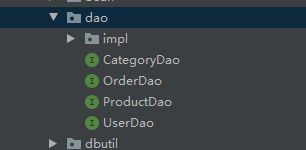

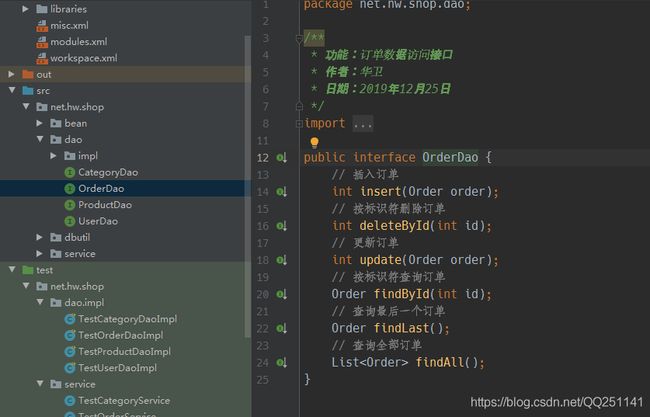
在这里插入图片描述
步骤六:数据访问接口实现类XXXDaoImpl
在src下创建net.hw.shop.dao.impl包,在里面创建UserDaoImpl、CategoryDaoImpl、ProductDaoImpl与OrderDaoImpl

步骤七:
我们需要对用户数据访问接口实现类的各个方法进行单元测试,采用JUnit来进行单元测试。
在项目根目录创建一个test文件夹,然后在项目结构窗口里将其标记为"Tests",这样文件夹颜色变成绿色。

在test文件夹里创建net.hw.shop.dao.impl包,在里面创建测试类TestUserDaoImpl:
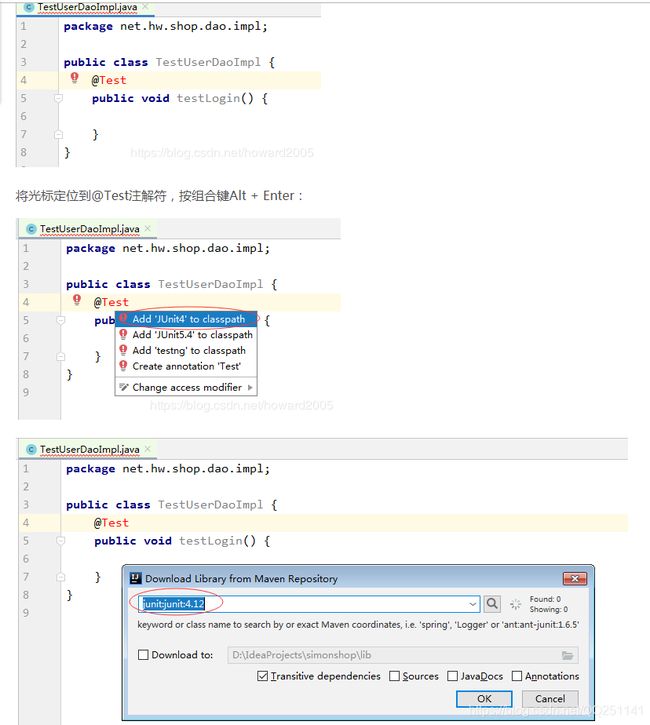

进行测试
步骤八:类别数据访问接口实现类CategoryDaoImpl

package net.hw.shop.dao.impl;
/**
* 功能:类别数据访问接口实现类
* 日期:2019年12月10日
*/
import java.sql.Connection;
import java.sql.PreparedStatement;
import java.sql.ResultSet;
import java.sql.SQLException;
import java.sql.Statement;
import java.util.ArrayList;
import java.util.List;
import net.hw.shop.bean.Category;
import net.hw.shop.dao.CategoryDao;
import net.hw.shop.dbutil.ConnectionManager;
public class CategoryDaoImpl implements CategoryDao {
/**
* 插入类别
*/
@Override
public int insert(Category category) {
// 定义插入记录数
int count = 0;
// 获得数据库连接
Connection conn = ConnectionManager.getConnection();
// 定义SQL字符串
String strSQL = "INSERT INTO t_category (name) VALUES (?)";
try {
// 创建预备语句对象
PreparedStatement pstmt = conn.prepareStatement(strSQL);
// 设置占位符的值
pstmt.setString(1, category.getName());
// 执行更新操作,插入新录
count = pstmt.executeUpdate();
// 关闭预备语句对象
pstmt.close();
} catch (SQLException e) {
e.printStackTrace();
} finally {
ConnectionManager.closeConnection(conn);
}
// 返回插入记录数
return count;
}
/**
* 删除类别
*/
@Override
public int deleteById(int id) {
// 定义删除记录数
int count = 0;
// 获得数据库连接
Connection conn = ConnectionManager.getConnection();
// 定义SQL字符串
String strSQL = "DELETE FROM t_category WHERE id = ?";
try {
// 创建预备语句对象
PreparedStatement pstmt = conn.prepareStatement(strSQL);
// 设置占位符的值
pstmt.setInt(1, id);
// 执行更新操作,删除记录
count = pstmt.executeUpdate();
// 关闭预备语句对象
pstmt.close();
} catch (SQLException e) {
e.printStackTrace();
} finally {
ConnectionManager.closeConnection(conn);
}
// 返回删除记录数
return count;
}
/**
* 更新类别
*/
@Override
public int update(Category category) {
// 定义更新记录数
int count = 0;
// 获得数据库连接
Connection conn = ConnectionManager.getConnection();
// 定义SQL字符串
String strSQL = "UPDATE t_category SET name = ? WHERE id = ?";
try {
// 创建预备语句对象
PreparedStatement pstmt = conn.prepareStatement(strSQL);
// 设置占位符的值
pstmt.setString(1, category.getName());
pstmt.setInt(2, category.getId());
// 执行更新操作,更新记录
count = pstmt.executeUpdate();
// 关闭预备语句对象
pstmt.close();
} catch (SQLException e) {
e.printStackTrace();
} finally {
ConnectionManager.closeConnection(conn);
}
// 返回更新记录数
return count;
}
/**
* 按标识符查询类别
*/
@Override
public Category findById(int id) {
// 声明商品类别
Category category = null;
// 获取数据库连接对象
Connection conn = ConnectionManager.getConnection();
// 定义SQL字符串
String strSQL = "SELECT * FROM t_category WHERE id = ?";
try {
// 创建预备语句对象
PreparedStatement pstmt = conn.prepareStatement(strSQL);
// 设置占位符的值
pstmt.setInt(1, id);
// 执行SQL查询,返回结果集
ResultSet rs = pstmt.executeQuery();
// 判断结果集是否有记录
if (rs.next()) {
// 实例化商品类别
category = new Category();
// 利用当前记录字段值去设置商品类别的属性
category.setId(rs.getInt("id"));
category.setName(rs.getString("name"));
}
} catch (SQLException e) {
e.printStackTrace();
} finally {
ConnectionManager.closeConnection(conn);
}
// 返回商品类别
return category;
}
/**
* 查询全部类别
*/
@Override
public List findAll() {
// 声明类别列表
List categories = new ArrayList();
// 获取数据库连接对象
Connection conn = ConnectionManager.getConnection();
// 定义SQL字符串
String strSQL = "SELECT * FROM t_category";
try {
// 创建语句对象
Statement stmt = conn.createStatement();
// 执行SQL,返回结果集
ResultSet rs = stmt.executeQuery(strSQL);
// 遍历结果集
while (rs.next()) {
// 创建类别实体
Category category = new Category();
// 设置实体属性
category.setId(rs.getInt("id"));
category.setName(rs.getString("name"));
// 将实体添加到类别列表
categories.add(category);
}
// 关闭结果集
rs.close();
// 关闭语句对象
stmt.close();
} catch (SQLException e) {
e.printStackTrace();
} finally {
// 关闭数据库连接
ConnectionManager.closeConnection(conn);
}
// 返回类别列表
return categories;
}
}
…
步骤九:类别服务类CategoryService

步骤十:
创建测试类TestCategoryDaoImpl,编写测试方法testFindAll():

步骤十一:
控制层(XXXServlet)
在src里创建net.hw.shop.servlet包,在里面创建各种控制处理类。

package net.hw.shop.servlet;
/**
* 功能:登录处理类
* 日期:2019年12月9日
*/
import java.io.IOException;
import javax.servlet.ServletException;
import javax.servlet.annotation.WebServlet;
import javax.servlet.http.HttpServlet;
import javax.servlet.http.HttpServletRequest;
import javax.servlet.http.HttpServletResponse;
import javax.servlet.http.HttpSession;
import net.hw.shop.bean.User;
import net.hw.shop.service.UserService;
@WebServlet("/login")
public class LoginServlet extends HttpServlet {
private static final long serialVersionUID = 1L;
protected void doGet(HttpServletRequest request, HttpServletResponse response)
throws ServletException, IOException {
// 设置请求对象的字符编码
request.setCharacterEncoding("utf-8");
// 获取会话对象
HttpSession session = request.getSession();
// 获取用户名
String username = request.getParameter("username");
// 获取密码
String password = request.getParameter("password");
// 定义用户服务对象
UserService userService = new UserService();
// 执行登录方法,返回用户实体
User user = userService.login(username, password);
// 判断用户登录是否成功
if (user != null) {
// 设置session属性
session.setMaxInactiveInterval(5 * 60);
session.setAttribute("username", username);
session.removeAttribute("loginMsg");
// 根据用户权限跳转到不同页面
if (user.getPopedom() == 0) {
System.out.println("用户登录成功,进入后台管理!");
response.sendRedirect(request.getContextPath() + "/backend/management.jsp");
} else if (user.getPopedom() == 1) {
System.out.println("用户登录成功,进入前台显示类别!");
response.sendRedirect(request.getContextPath() + "/showCategory");
}
} else {
System.out.println("用户名或密码错误,用户登录失败!");
// 设置session属性loginMsg
session.setAttribute("loginMsg", "用户名或密码错误!");
response.sendRedirect(request.getContextPath() + "/login.jsp");
}
}
protected void doPost(HttpServletRequest request, HttpServletResponse response)
throws ServletException, IOException {
doGet(request, response);
}
}
测试前,修改一下代码

测试结果

最后

我们用管理员的用户名与密码登录,确实跳转到后台的管理页面/backend/management.jsp,当然该页面尚未编写,因此报了个404错误。我们去看一下服务器端的控制台,结果如下:


建立注销处理类LogoutServlet
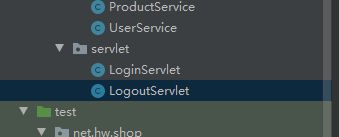
package net.hw.shop.servlet;
/**
* 功能:注销处理类
* 作者:华卫
* 日期:2019年12月9日
*/
import java.io.IOException;
import javax.servlet.ServletException;
import javax.servlet.annotation.WebServlet;
import javax.servlet.http.HttpServlet;
import javax.servlet.http.HttpServletRequest;
import javax.servlet.http.HttpServletResponse;
@WebServlet("/logout")
public class LogoutServlet extends HttpServlet {
private static final long serialVersionUID = 1L;
protected void doGet(HttpServletRequest request, HttpServletResponse response)
throws ServletException, IOException {
// 让session失效
request.getSession().invalidate();
// 重定向到登录页面
response.sendRedirect(request.getContextPath() + "/login.jsp");
System.out.println("用户注销成功!");
}
protected void doPost(HttpServletRequest request, HttpServletResponse response)
throws ServletException, IOException {
doGet(request, response);
}
}
下面我们来进行测试。启动服务器,先要登录成功,然后再测试注销功能。


输入logout回到登录页面

最后结果

注册处理类RegisterServlet
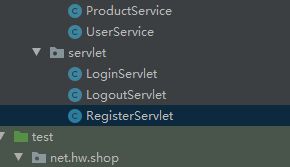
package net.hw.shop.servlet;
/**
* 功能:处理用户注册
* 日期:2019年12月9日
*/
import java.io.IOException;
import java.io.PrintWriter;
import java.net.URLEncoder;
import java.sql.Timestamp;
import javax.servlet.ServletException;
import javax.servlet.annotation.WebServlet;
import javax.servlet.http.HttpServlet;
import javax.servlet.http.HttpServletRequest;
import javax.servlet.http.HttpServletResponse;
import javax.servlet.http.HttpSession;
import net.hw.shop.bean.User;
import net.hw.shop.service.UserService;
@WebServlet("/register")
public class RegisterServlet extends HttpServlet {
private static final long serialVersionUID = 1L;
protected void doGet(HttpServletRequest request, HttpServletResponse response)
throws ServletException, IOException {
// 设置请求对象的字符编码
request.setCharacterEncoding("utf-8");
// 获取session对象
HttpSession session = request.getSession();
// 获取用户名
String username = request.getParameter("username");
// 获取密码
String password = request.getParameter("password");
// 获取电话号码
String telephone = request.getParameter("telephone");
// 设置注册时间(时间戳对象)
Timestamp registerTime = new Timestamp(System.currentTimeMillis());
// 设置用户为普通用户
int popedom = 1;
// 创建用户对象
User user = new User();
// 设置用户对象信息
user.setUsername(username);
user.setPassword(password);
user.setTelephone(telephone);
user.setRegisterTime(registerTime);
user.setPopedom(popedom);
// 创建UserService对象
UserService userService = new UserService();
// 调用UserService对象的添加用户方法
int count = userService.addUser(user);
// 判断是否注册成功
if (count > 0) {
// 设置session属性
session.setAttribute("registerMsg", "恭喜,注册成功!");
// 重定向到登录页面
response.sendRedirect(request.getContextPath() + "/login.jsp");
// 在控制台输出测试信息
System.out.println("恭喜,注册成功,跳转到登录页面!");
} else {
// 设置session属性
session.setAttribute("registerMsg", "遗憾,注册失败!");
// 重定向到注册页面
response.sendRedirect(request.getContextPath() + "/frontend/register.jsp");
// 在控制台输出测试信息
System.out.println("遗憾,注册失败,跳转到注册页面!");
}
}
protected void doPost(HttpServletRequest request, HttpServletResponse response)
throws ServletException, IOException {
doGet(request, response);
}
}


此时,我们去NaviCat查看用户表,看看是否插入了新的用户记录?

显示类别处理类ShowCategoryServlet

package net.hw.shop.servlet;
/**
* 功能:显示类别控制程序
* 日期:2019年12月9日
*/
import java.io.IOException;
import java.util.List;
import javax.servlet.ServletException;
import javax.servlet.annotation.WebServlet;
import javax.servlet.http.HttpServlet;
import javax.servlet.http.HttpServletRequest;
import javax.servlet.http.HttpServletResponse;
import javax.servlet.http.HttpSession;
import net.hw.shop.bean.Category;
import net.hw.shop.service.CategoryService;
@WebServlet("/showCategory")
public class ShowCategoryServlet extends HttpServlet {
private static final long serialVersionUID = 1L;
protected void doGet(HttpServletRequest request, HttpServletResponse response)
throws ServletException, IOException {
// 创建类别服务对象
CategoryService categoryService = new CategoryService();
// 获取全部商品类别
List categories = categoryService.findAllCategories();
// 获取session对象
HttpSession session = request.getSession();
// 把商品类别列表以属性的方式保存到session里
session.setAttribute("categories", categories);
// 重定向到显示商品类别页面(showCategory.jsp)
response.sendRedirect(request.getContextPath() + "/frontend/showCategory.jsp");
// 在服务器控制台输出测试信息
for (Category category: categories) {
System.out.println(category);
}
}
protected void doPost(HttpServletRequest request, HttpServletResponse response)
throws ServletException, IOException {
doGet(request, response);
}
}
package net.hw.shop.servlet;
/**
* 功能:显示商品列表的控制程序
* 通过业务层访问后台数据,
* 然后将数据返回给前台页面
* 日期:2019年12月9日
*/
import java.io.IOException;
import java.util.List;
import javax.servlet.ServletException;
import javax.servlet.annotation.WebServlet;
import javax.servlet.http.HttpServlet;
import javax.servlet.http.HttpServletRequest;
import javax.servlet.http.HttpServletResponse;
import javax.servlet.http.HttpSession;
import net.hw.shop.bean.Product;
import net.hw.shop.service.CategoryService;
import net.hw.shop.service.ProductService;
@WebServlet("/showProduct")
public class ShowProductServlet extends HttpServlet {
private static final long serialVersionUID = 1L;
protected void doGet(HttpServletRequest request, HttpServletResponse response)
throws ServletException, IOException {
// 获取类别标识符
int categoryId = Integer.parseInt(request.getParameter("categoryId"));
// 创建商品类别服务对象
CategoryService categoryService = new CategoryService();
// 由类别标识符获取类别名
String categoryName = categoryService.findCategoryById(categoryId).getName();
// 创建商品服务对象
ProductService productService = new ProductService();
// 获取指定商品类别的商品列表
List products = productService.findProductsByCategoryId(categoryId);
// 获取session对象
HttpSession session = request.getSession();
// 把商品列表对象以属性的方式保存到session里
session.setAttribute("products", products);
// 重定向到显示商品信息页面
response.sendRedirect(request.getContextPath() + "/frontend/showProduct.jsp?categoryName=" + categoryName);
// 在服务器端控制台输出测试信息
for (int i = 0; i < products.size(); i++) {
System.out.println(products.get(i));
}
}
protected void doPost(HttpServletRequest request, HttpServletResponse response)
throws ServletException, IOException {
doGet(request, response);
}
}


总结,最后的这个项目是一学期的内容整合,但是在整合的过程中又发现了自己的很多不足,刚开始我的tomcat配置有问题时,我只想逃避,坐着玩,后来还是认真的重新配置了,还帮助了身边的朋友配置tomact,有一种成就感,我想这是我学下去的动力

